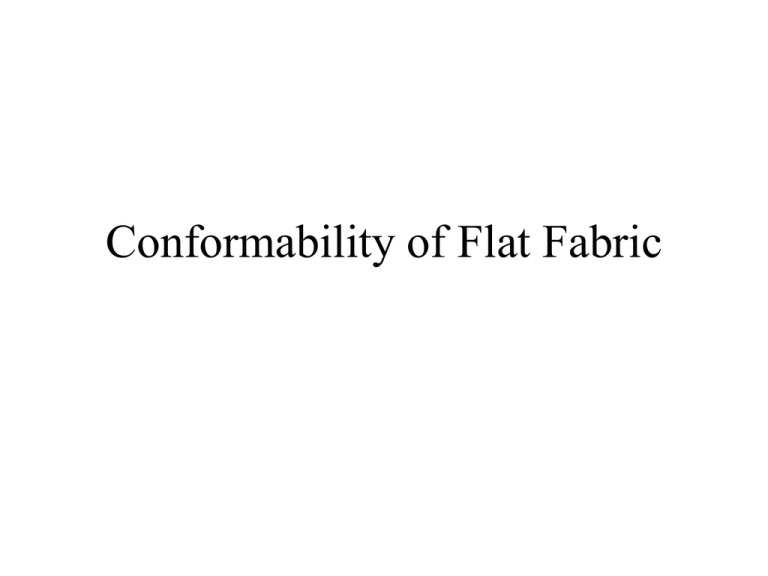Conformability
advertisement

Conformability of Flat Fabric Fabric Forms • Produce Woven and Braided fabrics from the flat tape yarn with different configurations • Evaluate processing issues • Characterize tensile, shear and conformability Woven Fabric • • • • Plain Weave Twill Weave (3/1) Satin Weave (8 harness) Texture: – 10 epi, 10 ppi (50/50) – 10 epi, 5 ppi (67/33) – 10 epi 2.5 ppi (80/20) Braided Fabric • Two braid types: – Biaxial Braid (64 carriers) – Triaxial Braid (64 carriers + 32 longitudinals) • Formed at four different mandrel diameters: • • • • 4.1 cm 4.3 cm 6.1 cm 8.9 cm – Made for high coverage, braid angle results from cover factor Woven Fabrics • Warp was produced by hand. It was possible to keep the yarns flat if the supply spool was kept horizontal and rotated to prevent twist. • Heddles had to be modified (flattened) to allow the yarn to stay flat during weaving. • Pick insertion required pull off from the spool to prevent twisting. • Some yarns split when they hit another object during weaving - heddle sides, another yarn, lease rods… Plain Weaves • Generally weave fine. Tight configuration much easier to produce (10/10) than looser ones Twill Weaves • End density was reduced rather than pick density to assist in weave production rates • Difficulty maintaining quality fabric with low end count (5/10 and 2.5/10) Satin Weaves • End density reduced, not pick • Sleazy fabric - difficult to handle, yarns move around Braided Fabrics • Bobbins were spooled by hand - supply of yarn was kept horizontal and rotated while winding to prevent twist buildup • Composites type carriers were used with large pigtails. • Generally braid formed well - at higher braid angles there was some yarn splitting • Braids were formed over cylindrical mandrels and then removed Biaxial Braided Fabrics • Four different diameter mandrels were used for production • When braids were removed from the mandrels, they reoriented to a stable configuration. Generally all the braids deformed to a similar shape Biaxial Braided Fabrics Biaxial Braided Fabrics Relaxed Braid Angles Biaxial Braided Fabric (64 Carriers) 40 38 Braid Angle (deg) 36 34 32 30 28 26 24 22 20 0 2 4 6 Mandrel Diameter (cm) 8 10 Triaxial Braided Fabrics • The Triaxial braid is a biaxial braid that has longitudinal yarns inserted at each horn gear. • 64 biaxial carriers are used plus an additional 32 triaxial (longitudinal) carriers. • Braiding went smoothly, similar to biaxial. • Fabrics were not removed from the mandrels for measuring braid angles Traixial Braids - As Formed Braid Angles Triaxial Braided Fabric (64 Carriers) 80 70 Braid Angle (deg) 60 50 40 30 20 10 0 0 2 4 6 Mandrel Diameter (cm) 8 10 Tensile Testing • Ravel strip method for wovens • Braid sleeve for braids Tensile Response - Strength 40 35 Strength (kg/cm) 30 25 20 15 10 5 0 Plain Warp Plain Fill Twill Warp Twill Fill Satin Warp Satin Fill Braid 1 Tensile Response - Strain to Failure 5 4.5 Strain to Failure (%) 4 3.5 3 2.5 2 1.5 1 0.5 0 Plain Warp Plain Fill Twill Warp Twill Fill Satin Warp Satin Fill Braid 1 Tensile Response - Modulus 3500 3000 Modulus (kg/cm) 2500 2000 1500 1000 500 0 Plain Warp Plain Fill Twill Warp Twill Fill Satin Warp Satin Fill Braid 1 Tensile Response - Poisson’s Ratio Tensile Response - Poisson 2.5 Poisson's Ratio 2 1.5 1 0.5 0 0 0.05 0.1 0.15 0.2 Axial Strain 0.25 0.3 0.35 0.4 Conformability • Fabrics were pressed against the surface of a sphere and the ratio of contact area to fabric area was determined. • Initially a bowling ball was used, but most of the fabrics conformed perfectly. • A smaller diameter sphere (bocce ball) was used to get more differentiation. Bowling Ball test Bowling Ball test • Only the Plain Weave had noticeable folds or wrinkles • Braided fabrics (small diameter mandrels) were not wide enough to get a full circle contact Bocce Ball Test - Plain Weave Bocce Ball Test - Satin • The border of the restraining ring and the folds/wrinkles were marked for measurements later Bocce Ball: Twill Bocce Ball: Braid Bocce Ball: Triaxial Flattened Images: Plain Weave Flattened: Twill Flattened: Satin Flattened: Braid Flattened: Triaxial Comparison of Conformability 100% 98% Conformability 96% 94% 92% 90% 88% 86% 84% 82% B1 B2 B3 B4 B5 B6 B7 B8 P1 P2 Sample ID P3 TW 1 TW 2 TW 3 S1 S2 S3










